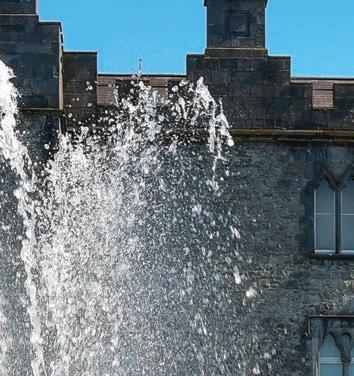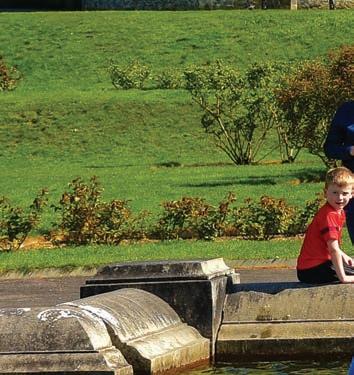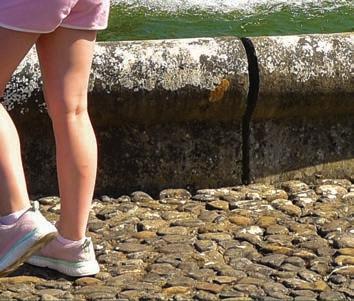
31 minute read
Travel & Leisure

Zagreb in Croatia — home to around 800,000 people — is often treated as a stopover for visitors on their way to the sea.
Advertisement
No matter. What lingering travellers quickly find is that this is a city that takes care of its own. Cafes spill across squares and streets, because Purgers (as folks from Zagreb call themselves) like to luxuriate over multi-hour, coffee-fuelled conversations.
Museums and galleries display world-class collections to accommodate local tastes, and the capital’s stages showcase productions for discerning native theatregoers. This isn’t a city that goes out of its way to cater for tourists, and it’s all the more beguiling for it. The key is for travellers to lean into the rhythms of local life.
Stretching north from the Sava River to the foothills of the Dinaric Alps, Zagreb’s neighbourhoods offer eclectic rows of architecture from secessionist and neo-Baroque to Gothic brutalist and beyond. But it’s the proliferation of parks, gardens and leafy hills that dominate Zagreb’s landscape, coming into spectacular bloom in spring but hosts for festivals year-round. With its easy, natural charm Zagreb isn’t a city that tries hard to win visitors over — so it’s almost quite likely, therefore, that it will.
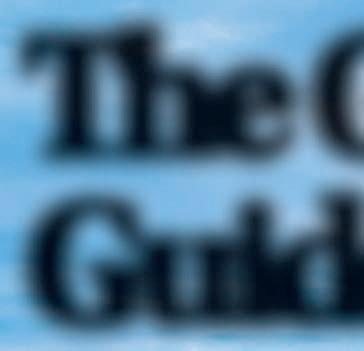

What to see and do
Green Horseshoe: Take a sightseeing stroll from the 19th-century, neoclassical central train station, Glavni kolodvor, to the main square, Ban Jelačić Square. From there, follow the aptly named ‘Green Horseshoe’ of parks and sites that wrap around Donji Grad, or Lower Town. As trams rumble by, you’ll pass the art deco Esplanade Zagreb Hotel, built in 1925 to accommodate Orient Express passengers.
Next door, the Zagreb Botanical Garden and its 10,000 plant species provide a peaceful oasis. The last stretch takes you through Zrinjevac Park, for regular live music sessions in the bandstand, surrounded by vibrant flowerbeds.
Zagreb Cathedral: It’s full name being the Cathedral of the Assumption of the Blessed Virgin Mary, the city’s top photo op stands on the spot where Zagreb was founded — an 11th-century bishopric known as Kaptol. Today’s neo-gothic cathedral — dating from 1880 — is the latest of several constructed over the ensuing millennium. It’s famed for its two 354ft spires, its goosebumps-inducing organ, with nearly 6,100 pipes, and for being the final resting place of beatified Cardinal Alojzije Stepinac.
Upper Town: Historically, Zagreb’s hilltop Upper Town, Gradec, was the merchant yin to Kaptol’s religious yang. Today, Gradec’s medieval spirit endures as you walk its tangle of cobbled streets, where gas lamps are still hand-lit every evening. After passing through the district’s Stone Gate — the last of four original, 13th- century entrances — you’ll find the Croatian Parliament en route to the showstopper: St Mark’s Church. This architectural masterpiece — a mix of romanesque and gothic styles — contains exquisite sculptures and is topped by roof whose colourful tiles depict the coat of arms of Zagreb and the historic Kingdom of Croatia-Slavonia.
Lari & Penati restaurant, serving up a fusion of Croatian and European fare.
Tkalčićeva Street: Or simply Tkalča, was once a creek dividing Kaptol and Gradec. These days, that waterway is a pedestrian-only promenade and the centre of Zagreb’s social scene. The row of two-storey, pastel-coloured buildings is an atmospheric place for a bite or a be — a backdrop for buskers, evening strollers, shoppers and lively social gatherings.
Museums and galleries: The Museum of Contemporary Art, south of the river, is a celebration of multimedia installations, imagination and societal commentary via a 12,000-strong collection. Zagreb City Museum, set in the cavernous former 17th-century Convent of the Clares in the Upper Town, explores the city’s history from prehistory onwards, while the nearby Museum of Broken Relationships displays painful, sweet and humorous items donated following failed romances.
Medvednica: After getting to know the Croatian capital on foot, head up to 3,396ft Medvednica (‘bear mountain’) for clear-day views that stretch as far as Slovenia, Hungary and the Adriatic coast. One of Zagreb’s most seductive qualities is its proximity to open countryside, and this peak, in the north of the city, is one of the most accessible spots, its slopes (part of Medvednica Nature Park) offering scores of hikes for trekkers of all abilities.
Špica: It seems the whole of Zagreb wakes early on Saturdays, flexes its collective fashion muscle and lounges at cafes in the centre to see and be seen. This weekend strut is known as špica. Pull on your best threads, take your špica waltz down Ilica Street, then duck into Eli’s Caffe for the city’s best kava. Owner and roaster Nik Orosi has turned a cup of coffee into an art form.
Gric Tunnel: This protective measure, built during the Second World War, runs under the city centre and serves as an occasional art venue. Emerge from Art Park Entrance 1 (one of multiple access points), and you’ll come face to face with two city landmarks: the Zagreb Funicular, which connects Upper and Lower
Towns, and the Lotrščak Tower, with its Grič cannon, which is fired daily at noon.
Croatian National Theatre: Zagreb is a city of theatregoers, who pack out its performance venues every night. A highlight is the 19th-century, neoBaroque Croatian National Theatre; anchoring the western arm of the Green Horseshoe, it stages drama, ballet and opera.
The Good Guide to Zagreb
Where to shop
Croata: Purgers are fashionable. Shop the look with hyper-local adornments like the necktie, invented in Croatia centuries ago and seen in adventurous iterations at this world renown emporium, which also stocks scarfs in unique designs.
Dora: This boutique is located in Gradec, between the Stone Gate and St Mark’s Church. Owner Dora Rubić creates bespoke women’s clothing, with a focus on coats and dresses. Using natural fabrics such as cashmere and alpaca wool, she only produces around 200 pieces a year.
Outdoor Markets: To really shop local, visit Zagreb’s openair markets. Climb the steps behind Ban Jelačić Square to reach Dolac Market, whose expanse of red umbrellas covers vendors selling fruit, vegetables, cheese, nuts, honey and liqueurs — accompanied by a cornucopia of local knowledge. Head west along Ilica Street to British Square, where, on Sunday mornings, antique dealers hawk everything from jewellery to Yugoslav memorabilia.
Where to eat
Broom 44: Spilling onto Dolac Market, this classic brunch spot seamlessly blends alternative cool with old- school hospitality, and, most importantly, its homemade vegan and vegetarian food — served on plates thrown by a local potter — is divine. Dolac 8, 10000. takes generous liberties with its fusion of Croatian and US fare, created using ingredients from nearby Dolac Market — accompanied by a sterling wine list. It’s impossible to go wrong with this menu, especially the marinated sea bass salad and the barbecue spare ribs.
Dubravkin Put: A short walk away from the main square, this retreat of a restaurant in Tuškanac Forest Park offers exemplary Zagreb fine dining: rustic but refined and replete with Croatian produce including fine home-grown wines. Expect seafood and specialities such as tuna tartar and slow-cooked veal cheeks with a morel sauce, served on white linen-clad tables both inside and outside on the lovely, leafy terrace.
Where to stay
Hotel President Pantovcak: A true boutique hotel, each of the 10 rooms at the four-star President is uniquely decorated with art — both modern and antique — while the elegant lounge and garden terrace would be worth a visit in their own right. It’s in a great location, too: a five-minute walk from British Square.
Where are you, Walter Lally …
Part 1
Well, Peamount TB Sanatorium, back in the 1940’s. For those of us who were ‘inmates’, it was – as Dickens would say – ‘the best of times, the worst of times’.
Two of my sisters had been swept away by the tide of consumption - as TB was so delicately termed. Whatever was consumed in our house, it was bought by the scrag ends of pennies the parasitic bookies hadn’t got their grasping co n- lling claws on.
I remember the rst night I was in this Peamount ‘prison’ - for that was how most of us rst regarded it. I’d known nothing of lavatories - the back eld being our only ‘evacuation centre’ – the school one being a hole in a board over a dreadful swamp of maggot-ridden ordure.
So, when nature called that rst night in the ward – in polite-speak - a Number Two - I held on as long as I could, then ‘went’ at the far end of a dim corridor. {Jaykers, sure I couldn’t nd a eld anywhere, in the dark. What a joint!}
Next morning, in comes clattering the gimlet-eyed nurse - Gallagher by name – she’s long dead now, I’d say. Turned me on my face in the bed to inspect the guilty area of my skinny frame. Saw the evidence – I couldn’t nd a bit of grass - and announced my guilt to the rest of the ward.
Strangely enough, she didn’t get the cheap derisive gale of laughter she was seeking. e twenty or so boys who had been standing beside their beds looked away from my shaming - just looked at the ground - or the bare wall opposite. I will forever remember their kindness.
My punishment, then, was to be taken down and stood outside the Admin o ce, in my shirt. Underpants didn’t even exist in the Ireland of those days. Well, in my Ireland, anyway. ey were years away. A very few of the nurses had their little laughs at the small scrawny country mug. But again, an unexpected kindness: a Sister Boyle, from Roscommon {I’ll never forget her} found me, gave a rollocking to the Gallagher wretch, and brought me back to my ward - calling into the pantry on the way to get me a few slices of bread and butter and a cup of milk: cripes! Epicurean Heaven!
After a few days, I got the hang of the place. Near-hunger was a constant companion. Probably part of the treatment, for all I knew. But what grub we got was well cooked, if a bit sparse. After tea at ve or six in the evening we would be herded into the wards, and expected to settle down for the night. But, weakened as we were, there was still plenty of “go” in us. Talk would go on amongst the older boys about the girls over in the “Old Wing”. Many of us formed fanciful ideas about imaginary ‘coorting’ with these completely unattainable angels - for such they seemed to be to us gawky lads.
I had a childish love for a little girl called Maisie, whom I’d seen at Mass one day. Because I knew nobody at home by the name of Maisie, I misheard the word, and went around bragging and boasting about ‘my mot, Lazy Leonard.’
I used to get in a real tiny fury when the other lads laughed at the name I had given this queen of my childlike imaginings – thinking they were just jealous of my obvious attraction to the young lady! Not too long afterwards, this little girl – whom I’d never even spoken to - went home. In a small white box. And it broke my heart, because she took with her the only thing any of us had – some kind of unreachable impossible dream. Some refuge from loneliness.
And the strange sad unusual thing was that when we found out she had passed away, without any prompting, in the dark of our old ramshackle winter-wind and rain-lashed wooden verandah, we all knelt down and said a little prayer for her. One of the few prayers I’ve ever really meant.
And the lads all told nice ‘moryah’ stories about poor little ‘Lazy,’ who hailed from the hills above Glenties, and who only saw ten summers. And I told the lads tales laced with the wildest imagery I could conjure up out of my child’s mind, about what larks and innocent trickings and hide-and-go-seekings Lazy and myself would get up to, on the way down to Collinstown to see Roy Rogers or Gene Autrey, in a cinema that probably never even existed.
And whether they believed the stories or not, they were listened to in respectful digni ed silence, and at the end there’d be many a quiet “good lad” and “we knew you could do it.”
I wasn’t alone – or even prominent – among the small seanchaís. ere were many who could ‘tell the tale’ - as we termed it – far better than I. And in our loneliness, far away from home, with no radio, our own thoughts and imaginations were all we had to help us through the long nights and days.
Most nights we would launch raids on the pantry, to get some bread and butter. Spies would be positioned: the warning whisper was always the word “Echo!” A sudden rush of scampering bare feet, and we would be back in our beds, slices hidden all over the place. Why the pantry wasn’t locked up, I never knew. I think the kind nurses {who were in a majority} turned a blind eye.
And, there were endless plans to escape. From memory, the strategy was always the same: get down to the gate - and go home from there! No thought went into plans for transport, food - or direction of travel. Colditz escape merchants we were not. Get to the gate – and o with us. And that would be the end of all our homesick misery. e desire to escape was imprinted deep on our consciousness. Horrendously poor and deprived though my background was, I yearned for the dark and the cold and the dirt of home, like a Sultan would for his Palace. I missed my mother terribly. I also missed my father, as I was too young to realise that it was his malign gambling addiction that was the dire and direct cause of all our horrors, including the death of three of my sisters.
One winter day, in the middle of a snowstorm, I made a break for it. Away with me across the playground, past the ghostly white ‘Jungle Gym’ and down towards the gate. But I’d been spotted, and a ‘posse’ was sent after me. I was captured down by the elm trees, not too far from the magic exit, and brought back.
Another sentence of standing half-naked outside the o ce door. And I could hardly believe my luck when, once again, along comes a certain Sister Boyle! And demanded my short trousers and shoes back, and that I be fed right there in the o ce.
Ned E
Part 2 in next week’s edition of e Kilkenny Observer



Diminish exam anxiety with SOMEGA
EXAM season is approaching and with it comes the usual stress and anxiety of reaching your full potential as well as the need to be at the peak of your health for the weeks ahead. To help support students through this time, SOMEGA, Ireland’s purest brand of health supplements has launched a special “Exam Support” health bundle. e Exam Support Bundle contains two of SOMEGA’s hero products for supporting brain health, memory, concentration and learning as well as combating stress.
SOMEGA’s Easy Omega-3 + Vitamin D3 with a natural peach/mango avour and creamy texture makes it an easy addition to the daily diet while the Liposomal Vitamin B-Complex + C with natural berry avour, provides a high-strength supplement with eight B-vitamins and Vitamin C.
As well as supporting brain health, these supplements also provide extra energy that is needed to tackle the books and retain thousands of hours of knowledge, while also helping to reduce tiredness and fatigue. Both products also provide important support for the immune system.
Formulated by food scientists and food scientists and nutritionists in West Cork, SOMEWest Cork, SOMEGA supplements GA supplements are created using are created using the purest ingredients which are sugar, gluten, are sugar, gluten, alcohol, yeast and soya free. ey are also non GMO and are sustainably packaged and produced.
SOMEGA cofounder and nutritionist Dr. Paula tritionist Dr. Paula Gaynor says, “ is Gaynor says, “ is time of year can be stressful for both students and parents as exams approach and we’re often asked about supplementation. First o , a varied, balanced and healthy diet will come rst as this is the foundation for a healthy life as well as getting enough sleep and exercise. Pairing high quality supplements with these core things will ensure that you are giving your body all that it needs to function and perform effectively. We underestimate the energy used by our brain and it’s obvious that this increases during exam time, therefore our B-Complex plus C and our Easy Omega-3 + Vitamin D are the perfect duo for supporting cognitive function as well as providing a much needed energy boost and immune support. “
SOMEGA supplements can be enjoyed straight from the spoon or added to cold drinks, juices and smoothies and can be purchased in local health shops including Food for Life, e Good Earth, and McCauley Pharmacies or online at gosomega.com

UK opposes EU Irish beef plan
Plans to create a special EU designation for Irish grass-fed beef are being opposed by the British Government.
In 2020, Ireland submitted an application to the EU to obtain PGI status for Irish grassfed beef and it was hoped the status could have signi cant bene ts for all those in the beef supply chain — particularly beef farmers who hope the change would lead to higher market returns for their cattle.
PGI status aims to protect the names of speci c products to promote their unique characteristics, linked to their geographical origin as well as traditional know-how. at said, Agriculture Minister Charlie McConalogue has disclosed that in March, the EU Commission noti ed his department that the UK authorities had submitted a ‘Notice of Opposition’ to Ireland’s application.
Further, a letter from the European Commission received by the department invited Ireland and the Commission to engage on the issue.
Why Britain is opposed is unclear.
However, Ireland’s application had raised concerns among farmers in Northern Ireland.
In November 2020, the Ulster Farmers Union (UFU) con rmed to the weekly Farming Independent that it “will be left with no option but to object the proposal” if Northern Ireland is not included in the application to register from the outset when it is submitted to the European Commission.
Minister McConalogue said his department, along with Bord Bia, was examining the statement of opposition submitted by the UK.
“For some time now, my department and An Bord Bia have fully engaged with their counterparts in Northern Ireland to share information and provide advice on the technical aspects of a grass-fed standard and related matters associated with the possibility of having an all-island PGI for Irish grass-fed beef.
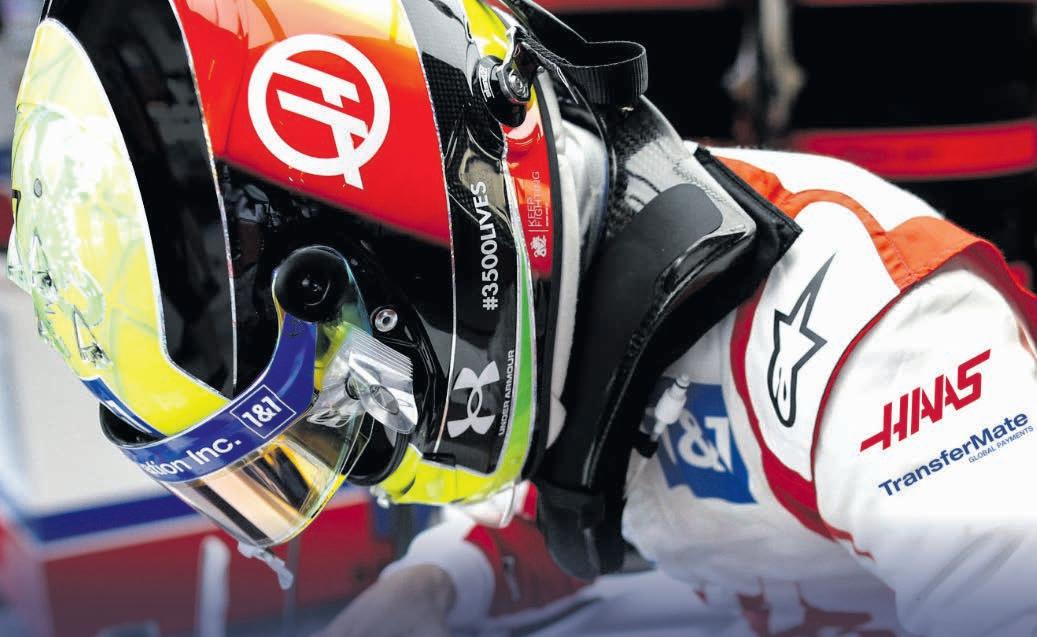
Vroom... Vroom...Vroom... TransferMate
Kilkenny company TransferMate has teamed up with the Haas Formula One out t. e multinational company, which is based at the IDA Business & Technology Park o the Ring Road, recently announced its world-wide partnership with the racing team.
As part of the partnership, TransferMate will provide cross-border payments services through its global payments infrastructure.
e Kilkenny-headquartered company’s logo will also feature on Haas’ car and the clothing of drivers Kevin Magnussen and Mick Schumacher throughout the 2022 season. e nancial terms of the agreement have not been disclosed.
Announcing the deal, TransferMate chief executive Sinead Fitzmaurice told e Kilkenny Observer: “ e partnership brings together two like-minded organisations, each with a strong commitment to challenging norms through innovation.
“We’re looking forward to seeing our partnership group throughout the 2022 Formula One season. It promises to be a very exciting year for both ourselves and the Haas team.”
Haas’ team principal Günther Steiner added: “We’re delighted to welcome TransferMate and we look forward to a productive working partnership in 2022 and beyond.
“It’s clear that as a brand TransferMate prides itself on the delivery of the very best product. We share that ethos and, ultimately, we’re both in sectors where innovation is rewarded and actions need to be executed with con dence and precision.
“E ciency is key to everything we do in Formula One and working with TransferMate adds another deliverable to our operations.” e arrangement with TransferMate is the rst major sponsorship deal Haas have signed since cutting ties with former title sponsor Uralkali as a result of Russia’s invasion of Ukraine. e team has been looking to ll the commercial void left by the Russian potash fertiliser producer, though matters have been complicated with Uralkali reportedly requesting a US$13 million refund and US$8.6 million in compensation.
Bord Bia announces Interim CEO role

Bord Bia, the Government agency responsible for the promotion of the food, drink, and horticulture industry globally, is pleased to announce that Michael Murphy, Organisation and Industry Talent Development Director, Bord Bia, will assume the role of Interim CEO in June.
As previously announced, Tara McCarthy is stepping down as CEO in June 2022 and Mr Murphy will work alongside her until her departure.
Mr Murphy has extensive experience in leading a number of Bord Bia departments in the last 20 years. He progressed from managing Bord Bia’s London O ce to leading its European o ce network and was Markets Director for nine years. He has been involved in the development and execution of strategy as part of the senior leadership since 2007.
He was responsible for the development of Bord Bia’s Talent Academy including ve MSc programmes with two universities. Mr Murphy began his career as a policy analyst in the IFA and has worked in the Departments of Agriculture and Environment.
Major road works ahead: where to avoid
Road works still need to be completed in Kilkenny between the junction of the N24 and Clairín Close/ Circle K, along the N24 to the junction of the N24 (O’Mahony Avenue) and the R696 at O’Connors Bar.
To facilitate major watermain works on O’Mahoney Avenue, there will be a local diversion in place for traffic travelling due west to Clonmel on the N24 until Monday, May 9. Traffic will be directed to make a left onto the R676 along New Street, making a right onto Main Street re-joining the N24 via the R885.
Irish Water’s customer care helpline is open 24/7 on 1800 278 278 and customers can also contact us on Twitter @IWCare with any queries. For updates please visit the Water Supply Updates section of the Irish Water website or set your location on our website www.water.ie Since 2018, Irish Water has invested over €500 million to upgrade the underground water network across the country through the delivery of the Leakage Reduction Programme. We are investing a further €600 million up to the end of 2024 - fixing leaks and replacing pipes to provide a more reliable water supply.



Time for a balance to be struck, to counteract detrimental effect on our planet
Kilkenny school teacher Sean Hickey looks at the message from Pope Francis and asks what we as individuals can do to assist in restoring the world around us
24 standard and semi mature native trees as well as over 300 native whips were planted in Ardnore Quarry park. The County Council, KKB and Local Residents were responsible for this tree planting initiative which will augment the existing Black Quarry Woodland habitat making it much more attractive to pollinators and wildlife and is part of the KKB 8000 tree biodiversity and climate change challenge

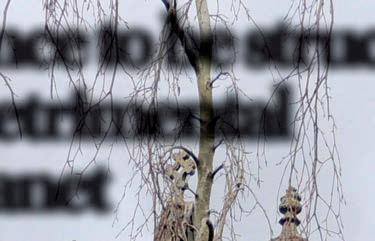
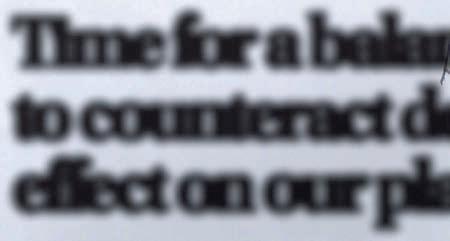
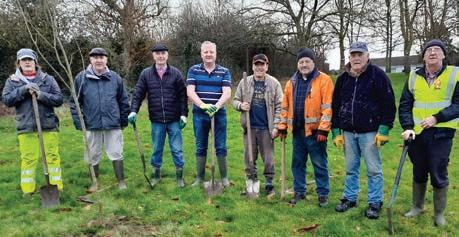

The Ordination tree planted at St Kieran’s College Kilkenny. A weeping Copper Beech (Fagus sylvatica pendula),planted in December 2021 at St Kieran’s College. There was a weeping Ash in the same position and it had started to die as a result of ‘ash die back disease’. It was decided to replace it with a semi-mature tree that was similar to the one removed. The name ordination tree derives from the fact that photographs were taken in front of the tree on ordination days at the college over the years.( jbs photos)

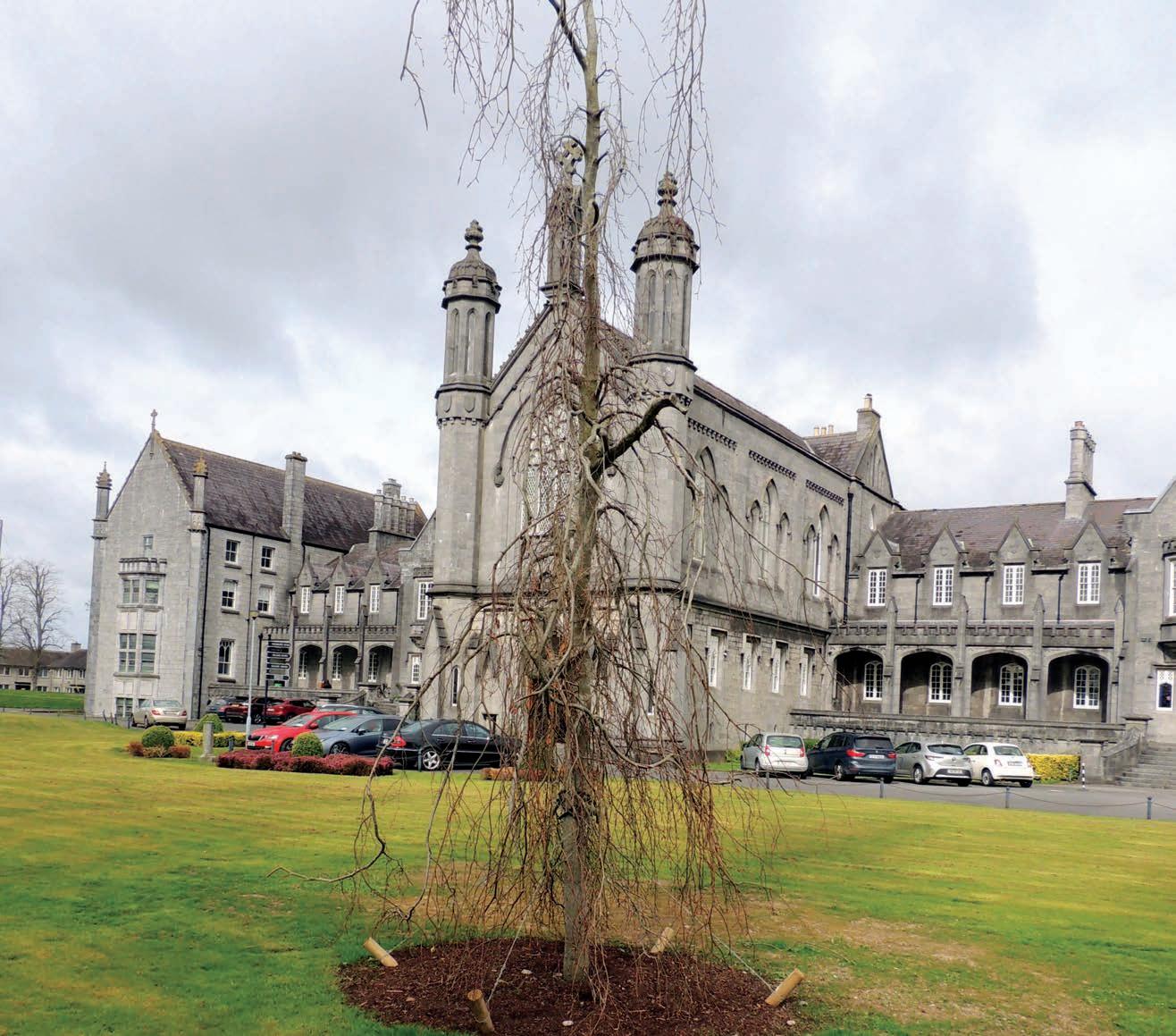
The thirteenth day of March 2013 marked the beginning of a new Papacy, a new charism and a new journey for the Roman Catholic Church. e newly elected Pope Francis began his papacy in a spirit of simplicity and empathy. e choice of the name was a bold statement to the Church and the world that the life of the great Saint Francis was as relevant in contemporary times as it was eight hundred years before. e Pope and the Saint both chose a new way,- a way that meant casting o the shackles of tradition and expectation that would allow them to live simpler lives, focussing on things of greater importance. Francis the Saint lived a life that was in harmonious union with God through his appreciation of creation and his vision of all that exists as part of a harmonious whole. within which we live. We must, therefore, make a deliberate choice to cast o the restraints that prevent us from entering fully into this communion. e gift of wonder and awe, as given to each of us by the Holy Spirit, is alive deep within our being and we must allow this gift to manifest itself in nurturing, caring for and restoring God’s creation. e question to be posed is what we as individuals can do to assist in caring for and restoring the world around us.
Saint Francis is the patron saint of the environment and he demonstrated a unique appreciation for all living creatures as well as the inanimate elements, understanding all as being created by God and working in unison to enable the world to function. In his Canticle of the Creatures, Francis recites ‘praised be you my Lord, with all your creatures’ and he speaks of brother sun and sister moon.
He personi es all that has been created as brother and sister and, in so doing, comes to a deeper understanding of the importance of a relationship built on respect and care for all that exists.
It is appropriate indeed that Pope Francis entitled his 2015 Encyclical ‘Laudato Si’ – praised be you.
Both the Saint and the Pope understand the essentiality of praising God through sincere care for His creation.
PROVIDING FOR HUMANITY IN THE FUTURE
e question to be posed is what we as individuals can do to assist in caring for and restoring the world around us so that it continues to provide for humanity into the future.
To begin, we must re ect upon and question our own individual existence, our way of life and the manner in which we contribute to the care of others and the care of the world around us.
As Christians, we believe that all we possess is a free gift from God. We must respect and cherish these gifts and share them equitably; we must utilise them in a sustainable fashion so as not to undermine the delicate, co-existent balance of the environment around us.
A balance must be struck between what we consume and what we give back in order to counteract the detrimental e ect our consumption has, as individuals, on our planet.
We must once more become symbiotic creatures and not parasites that think of the now and leave the future to chance. e Pope’s encyclical ‘Laudato Si’ addresses a broad range of topics and regards the world and its complex systems as a shared common good.
He delves into the problems we face as a result of pollution, the loss of biodiversity and accelerating climate change and the injurious e ects these factors have on the quality of life for all human beings, not least those on the margins.
Having outlined the problems confronting us, the Encyclical o ers a solution with the words: ‘many things have to change course, but it is we as human beings above all who need to change’. rough reducing our consumption of unnecessary goods and reinvesting our energy into a lifestyle that is self-su cient, or at least communally e cient, and by redirecting our energy into projects that contribute to the preservation and restoration of ‘mother earth’, we as individuals can change and improve the world’s prospects by doing our ‘small bit’ for the greater good. ere are various methods and means by which a contribution can be made at local level which would have consequences on a global scale if each local community participated in projects that seek to ‘balance the books’ between over-consumption and replenishing the environment within which we live.
KEEP KILKENNY BEAUTIFUL IS GOOD EXAMPLE
e local Tidy Towns Committee, Keep Kilkenny Beautiful, is a case in point and is currently undertaking a tree cover master plan for Kilkenny City. is project is no small feat and will result in an integrated plan for the city that will see all passive areas of land within the urban core and suburban hinterland planted with trees. Tree planting has many and varied bene ts: through tree planting initiatives such as these, habitats are recreated or restored resulting in an increase in biodiversity and natural amenities. Trees sequester carbon and thus contribute to averting climate change. ey bring humanity closer to nature and thus closer to God. rough the creation of habitats and natural landscapes and the planting of trees, hedges, and shrubs substantial bene ts accrue to people in the area of health and wellbeing. Exercising in areas rich in biodiversity and natural landscape promote positive mental health as people contemplate their surroundings and absorb the natural aesthetic.
FINDING SPIRITUAL BENEFITS IN NATURE
ere are also bene ts of a spiritual nature in pursuing such initiatives. e projects themselves allow people to engage in community activism and volunteerism, thus creating a sense of purpose and belonging to a community of like-minded individuals. e resulting habitat creation appeals to each person’s attraction to beauty which is innate within the human person, combined with a renewed sense of wonder and awe for creation and the intrinsic relationship we as individuals have with our environment. At present, the Tidy Towns Committee is in the planning phase of this project and planting commenced in the early part of 2022. e Committee is currently engaged with various other stakeholders and voluntary groups in identifying suitable locations for the planting of saplings and standard trees. e Committee is part-funding the purchase of standard trees for community-owned land and voluntary groups including church land, residential areas, schools, sports elds, and other areas where land is under-utilised or is passive in nature. e breadth of this project creates potential for the individual to contribute positively to the ght against the degradation of the world around us through identifying potential areas to be planted, contributing toward nancing the project, or the hands-on approach of the planting of the trees. is year brought an enlightened and positive development as St Kieran’s College planted ten standard trees to maintain the beauty of the College Park for future generations, whilst also playing its part in following in the footsteps of Francis the Pope, and Francis the Saint. ‘ e gravity of the ecological crisis demands that we all look to the common good, embarking on a path of dialogue which demands patience, self-discipline and generosity, always keeping in mind that realities are greater than ideas’.
It is now time to act in averting any further damage to our planet and to restore it to its natural state in so far as possible, for actions speak louder than words.
Sean Hickey at The Palm House at Kew Gardens, The Royal Botanical Gardens, London


Elaine and George Dunne directors of Water Babies South East and their team are delighted to be celebrating 10 years in business

ELAINE was rst introduced to Water Babies by friend and Water Polo team mate erese Mc Nally who along with her Sister Carol set up Water Babies in Dublin 13 years ago. “ From the minute I watched the Water Babies dvd I was hooked” says Elaine and “ I knew straight away that this is what I wanted to do” Qualifying as a teacher and teaching classes for erese and Carol in Dublin for two years before setting up her own classes in the South East in May 2012.
It was a huge decision for Elaine and George to move from Dublin to Wexford along with their four children and set up a new business and home in Fethard On Sea.
George followed Elaine in the teaching training programme and classes commenced in May 2012 with classes in Wexford, Waterford and Kilkenny. Starting with just under 100 clients, business began to grow rapidly. With the recruitment of full time Client Services Manager Amanda O’Grady in January 2014, this enabled Elaine and George time to leave the o ce and expand set up and teach classes in Carlow, Gorey, Clonmel and Cashel. 10 years on Elaine and George, have six part time teachers, one full time Client Services Manager and one full time Client Services Administrator and four part time poolside assistants.
“Babies love swimming! Says Elaine “It is entirely natural to them, because they’re free from restrictions of gravity and able to use muscles they’d never use until they start rolling, crawling, walking, running, babies love the sense of freedom water gives them”
Baby swimming is academically proven to have a number of physical, mental and emotional bene ts. By the time they start school, children who have been to structured swimming classes in the early years were found to be ahead of their non-swimming peers by 11 months when it comes to oral expression. Despite looking gentle, swimming provides a complete physical workout. It strengthens the heart, lungs and respiratory system, which in turn aids the development of the brain. e lessons are often a strengthening bond between parent and child whilst there is also emphasis on water safety and awareness.


To nd a class that suits you, check out Waterbabies.ie or call Elaine and her lovely team on 051 561898 or email monkeymonkey@waterbabies.ie
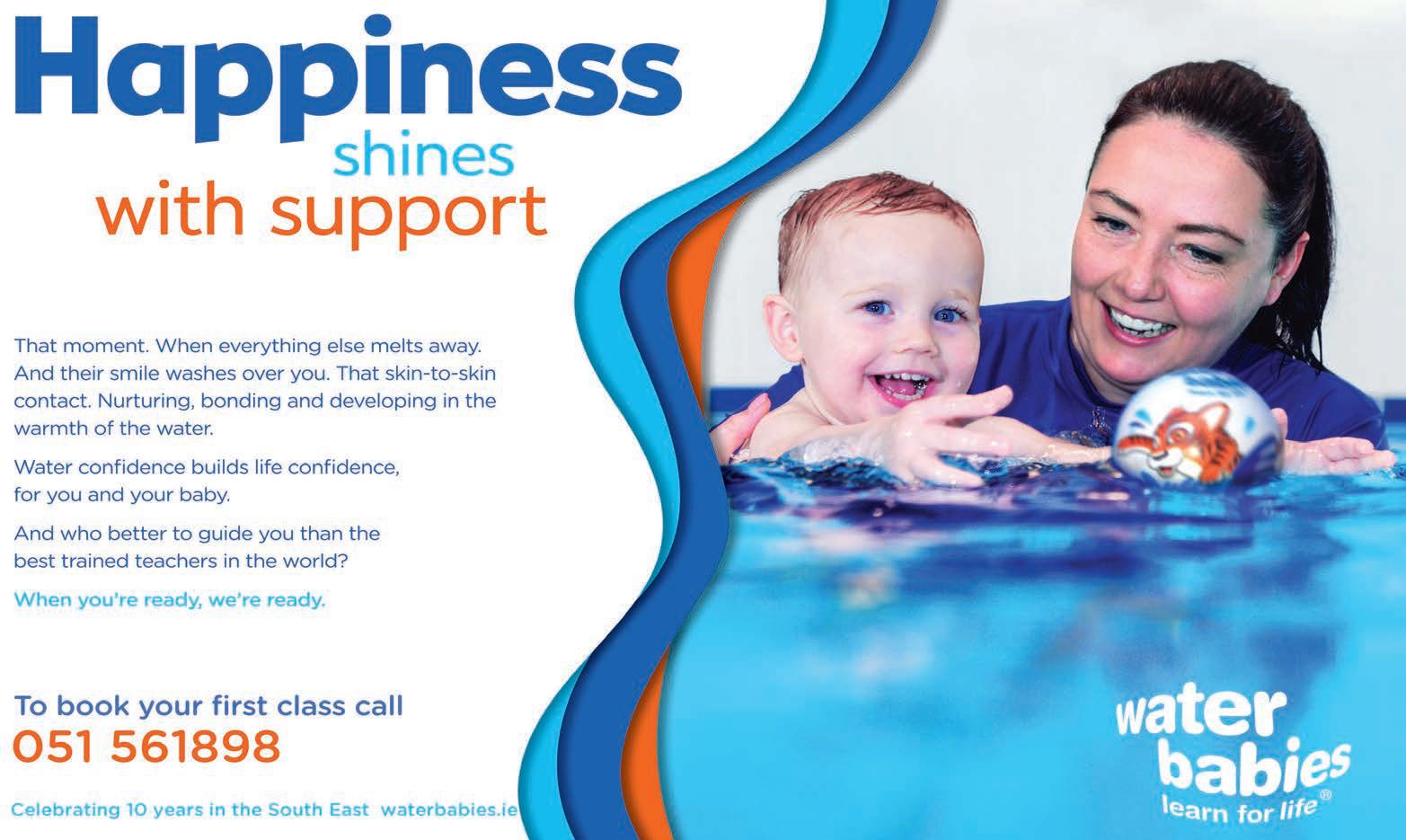

Mr Moonshine










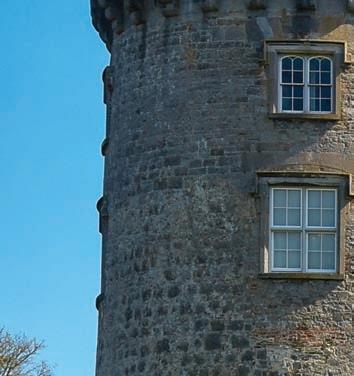
Adam Nolan Garda Andy Neill
PJ O’Neill

